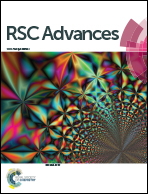The synthesis of nano-silver/sodium alginate composites and their antibacterial properties
Abstract
Nano-silver/sodium alginate (Ag/SA) composites were synthesized by an effective strategy. A sodium alginate (SA) solution was mixed with a silver nitrate solution and heated under normal pressure to afford Ag/SA by the in situ reaction of the liquid phase where SA acted as both a reducing and stabilizing agent. The developed Ag/SA composites were characterized using UV-visible, XRD, TEM and TGA to understand their physical and chemical properties. These Ag/SA composites showed antibacterial activity towards Escherichia coli ATCC 25922 and Staphylococcus aureus ATCC 25923.


 Please wait while we load your content...
Please wait while we load your content...